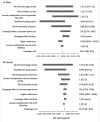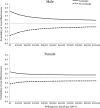Cost-Effectiveness of a Statewide Campaign to Promote Aspirin Use for Primary Prevention of Cardiovascular Disease
- PMID: 26702086
- PMCID: PMC4845274
- DOI: 10.1161/JAHA.115.002321
Cost-Effectiveness of a Statewide Campaign to Promote Aspirin Use for Primary Prevention of Cardiovascular Disease
Abstract
Background: The U.S. Preventive Services Task Force in 2009 recommended increased aspirin use for primary prevention of cardiovascular disease (CVD) in men ages 45 to 79 years and women ages 55 to 79 years for whom benefit outweighs risk. This study estimated the clinical efficacy and cost-effectiveness of a statewide public and health professional awareness campaign to increase regular aspirin use among the target population in Minnesota to reduce first CVD events.
Methods and results: A state-transition Markov model was developed, adopting a payer perspective and lifetime time horizon. The main outcomes of interest were quality-adjusted life years, costs, and the number of CVD events averted among those without a prior CVD history. The model was based on real-world data about campaign effectiveness from representative state-specific aspirin use and event rates, and estimates from the scholarly literature. Implementation of a campaign was predicted to avert 9874 primary myocardial infarctions in men and 1223 primary ischemic strokes in women in the target population. Increased aspirin use was associated with as many as 7222 more major gastrointestinal bleeding episodes. The cost-effectiveness analysis indicated cost-saving results for both the male and female target populations.
Conclusions: Using current U.S. Preventive Services Task Force recommendations, a state public and health professional awareness campaign would likely provide clinical benefit and be economically attractive. With clinician adjudication of individual benefit and risk, mechanisms can be made available that would facilitate achievement of aspirin's beneficial impact on lowering risk of primary CVD events, with minimization of adverse outcomes.
Keywords: aspirin; cardiovascular diseases; cost–effectiveness analysis; epidemiology; myocardial infarction; prevention; stroke.
© 2015 The Authors. Published on behalf of the American Heart Association, Inc., by Wiley Blackwell.
Figures



Comment in
-
Within-the-Clinic Shared Decision for an Over-the-Counter Medication.J Am Heart Assoc. 2015 Dec 23;4(12):e002927. doi: 10.1161/JAHA.115.002927. J Am Heart Assoc. 2015. PMID: 26702080 Free PMC article. No abstract available.
References
-
- Murphy SL, Xu J, Kochanek KD. Deaths: Preliminary Data for 2010. Natl Vital Stat Rep. 2012;60:1. - PubMed
-
- Fryar CD, Chen T, Li X. Prevalence of uncontrolled risk factors for cardiovascular disease: United States, 1999–2010. NCHS data brief, no 103. Hyattsville, MD: National Center for Health Statistics; 2012. - PubMed
-
- Yusuf S, Reddy S, Ôunpuu S, Anand S. Global burden of cardiovascular diseases part II: variations in cardiovascular disease by specific ethnic groups and geographic regions and prevention strategies. Circulation. 2001;104:2855–2864. - PubMed
Publication types
MeSH terms
Substances
Grants and funding
LinkOut - more resources
Full Text Sources
Medical

